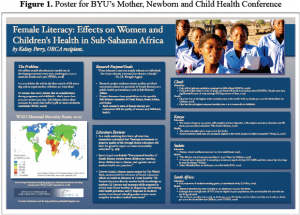Kelsey Perry and Professor Stephanie Fugal, Department of Health Science
Many NGOs and government agencies around the world are working tirelessly to eradicate poverty, sickness, and illiteracy from developing countries. Recent research has indicated that implementing female literacy programs could help solve both the problems of poor health outcomes and illiteracy. One of the purposes of our ORCA research has been to evaluate recent studies and their conclusions about the potential of female literacy as a public health preventionary tool in Sub-Saharan Africa. Results from the studies were bold and catalyzing, frequently calling for greater use of female literacy to affect African health. One study, which evaluated the effect of health teaching upon women in African villages, concluded that village women with higher education were better able to understand health education messages (Barrett & Browne, 1996). Another researcher, whose study revolved around Moroccan health, summarized the relevance of female education effects on health in Morocco in 3 basic benefits: “(1) Formal education directly teaches health knowledge to mothers; (2) Literacy and numeracy skills acquired in school assist future mothers in diagnosing and treating child health problems; and (3) Exposure to modern society from formal schooling makes women more receptive to modern medical treatments” (Glewwe, 1999). These conclusions aid in demonstrating how female literacy can specifically affect the health of both the educated mother and her children. Spratt (1992) also discussed the positive impact of female literacy in Morocco, and promoted the great need for more literacy programs and educational institutions. Documented benefits of female literacy in this study included fewer children per mother, fewer children lost to disease, and a greater use of modern health care practices.
Another study, by McAllister and Baskett (2006), concluded with even more significant findings. Researchers were distressed by the fact that “approximately 600,000 women between the ages of 15 and 49 die each year” because of complications during pregnancy and childbirth—a figure that may be underestimated by as much as 25% (p. 984) They performed polynomial regression analysis for 148 countries, and examined the impact of gender-related predictors, including “education, political activity, economic status, and health, and human development predictors [that] examined the relationship between women’s status, human development, and maternal mortality” (p. 983). After analyzing data from the 148 countries, researchers found that the combined enrollment ratio for females had a p-value of 0.004, which was a “significant and moderately powerful [predictor] of maternal mortality rates” (p. 985). Additionally, female education predictors explained about 50% of variance in data. They concluded, “Strategic investment to improve quality of life through female education will have the greatest impact on maternal mortality reduction” (p. 983, emphasis added). Of all the potential effects on maternal mortality, female education had the greatest association with and potential benefits toward maternal mortality rates. This has been the repeated conclusion of many researchers, including ourselves.
After reviewing the possibilities female literacy in current research and literature, we evaluated the current situation and effect of female literacy upon health in the specific Sub-Saharan countries of Chad, Kenya, South Africa, and Sudan. Each country’s rates of female literacy were contrasted with its quality of women and children’s health. The data and conclusions regarding Chad and South Africa were included in our paper which was published in The College of Health and Human Performance: Student Journal, as well as presented in poster format (along with the former literature review and information on Sudan and Kenya) at BYU’s Mother, Newborn, and Child Health Conference (see Figure 1). These data and conclusions indicated that female literacy in the aforementioned countries does in fact affect the health of women and children, and that further research should be done with regards to the ideal implementation of female literacy and health literacy programs.

Finally, our project concluded in an IRB-approved pilot study of female Kenyan attitudes towards the effects of female literacy upon personal and community health. Women who responded generally felt that female literacy and education positively affected personal and community health. The following is one response indicating a positive association: “Has your education provided you with a greater ability to obtain health care and health prevention measures (immunizations, regular check-ups, etc.)? Yes, I was able to be tested for HIV and live a positive way of life with ease.” Another participant, regarding the effect of education on her personal health, wrote: “Education has helped me understand principles of health esp relating to women and children’s health since I can read, search info online or talk to medical practitioners.” There was also helpful feedback on the nature of the questions, which we will utilize in future graduate studies in order to design specific and culturally-sensitive questions.
This project has demonstrated the great potential of female literacy as a public health preventionary tool, and we are grateful for the opportunity we have had to learn more about this great intervention. We look forward to utilizing this knowledge in future projects and research. For more information on our project, please see our blog: girlsliteracyandhealth.blogspot.com.
